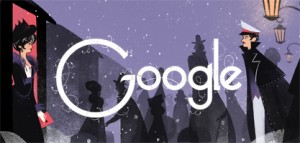Promoting literature with the Google doodle
Promoting literature with the Google doodle
Promoting literature with the Google doodle
-
Hannah
-
Hannah
Do you use Google as a browser? If so, you may have noticed, on 9 September, that Google marked 186 years since the birth of writer Leo Tolstoy with a slideshow of images: from Tolstoy writing by candlelight, to the first meeting of Anna and Vronsky in Anna Karenina, and Pierre Bezukhov of War and Peace captured in this moment:
He gazed joyfully, his eyes moist with tears, at this bright comet which, having travelled in its orbit with inconceivable velocity through immeasurable space, seemed suddenly – like an arrow piercing the earth – to remain fixed in a chosen spot, vigorously holding its tail erect, shining and displaying its white light amid countless other scintillating stars. It seemed to Pierre that this comet fully responded to what was passing in his own softened and uplifted soul, now blossoming into a new life.
The artist of the doodles, Roman Muradov, is reported in the Guardian as having found the task daunting, but said he hoped his artwork would “inspire viewers to discover and revisit these scenes in the way Tolstoy intended: through reading and rereading his timeless narratives”.
The Google doodle, as is called, was devised by the Google founders, and was first trialled in 2000 to celebrate Bastille Day. That first doodle was so popular, more doodles were created until Google hired an entire team of doodlers who, collectively, have created more than 2,000 doodles published on the homepage. Google notes that:
Doodles are the fun, surprising, and sometimes spontaneous changes that are made to the Google logo to celebrate holidays, anniversaries, and the lives of famous artists, pioneers, and scientists.
‘Artists’ in this context includes writers – Google has published doodles commemorating the lives and works of writers as diverse as Zora Neale Hurson, Mark Twain, Jorge Luis Borges, Herman Melville and Elizabeth Barrett Browning. In doing so, Google bringswriters before millions of people worldwide. What power it wields!
Could the Google doodle be a useful tool in reviving the classics? In promoting literacy? In encouraging those who don’t read to read, and those who do to try out new works? I hope so – but while I admire the doodlers’ ability to pictorialize a work of literature, I would love to see quotations worked into the doodle – for it is the words that matter most, and the words that have most power to engage.
What do you think? Do you notice the doodles? Do they affect you? What doodles would you like to see incorporated? If you’re a Google user, you can suggest your own ideas via [email protected].
